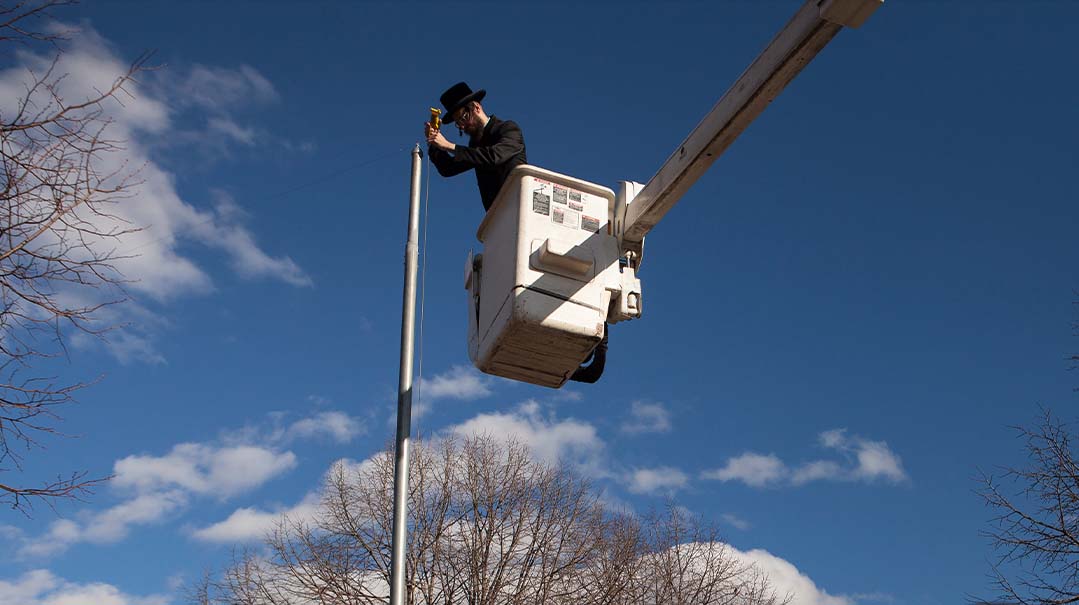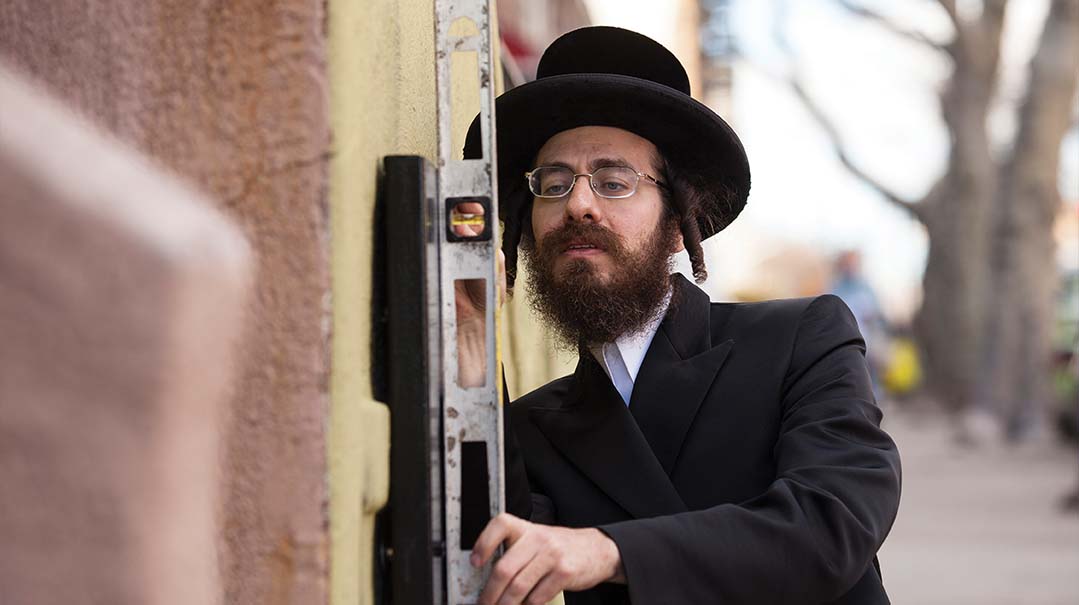Strings Attached
| March 2, 2016It might be little more than a stick and a wire, but getting an eiruv off the ground can be tricky as a tightrope walk.

Photos: Amir Levy
While rabbanim prepare for Shabbos in many different ways, Rav Moshe Yosef Unsdorfer spends his Erev Shabbos fielding sh’eilos from around the world over issues that arise on eiruvim.
An international eiruv expert, Rav Unsdorfer might be best known as the leading mashgiach of eiruvim in the Tristate area, but he never turns down smaller communities — like the kehillah in New Orleans, and others in cities around the world such as Montreal, Vienna, and Manchester, where his know-how has been indispensable — all l’sheim mitzvah.
At times, Rav Unsdorfer is dragged into legal battles, like the recent high-profile fight over the eiruv in Westhampton Beach, Long Island. The victory in that struggle followed six years of litigation initiated by the non-Jewish and Reform townsfolk who feared an influx of Orthodox Jews to the Hamptons. The anti-eiruv group, which called itself Jewish People for the Betterment of Westhampton Beach, were in a panic over the eiruv request of the few dozen Orthodox families affiliated with the Hampton Synagogue.
“I should not be forced to live in any area demarked for one religious sect,” the group’s president, a “proud Reform Jew,” told the media, expressing fears that a few pieces of PVC would open the way for more Orthodox “who will change the character of our town.”
The pro-eiruv forces assembled a legal team that included prestigious attorneys Yehudah Buchweitz, Robert Sugarman, and Morris Tuchman. Thanks to their persuasive arguments, the State Supreme Court ruled at the beginning of this year that the ritual boundary — created by a series of narrow, nondescript plastic strips (lechis) placed on the village’s utility poles, allowing Torah-observant Jews to carry permitted items on Shabbos — would not violate the town’s signage rules or strictures on the separation of church and state.
The court’s decision meant that an eiruv is not regarded as a religious symbol. “Because of the court’s prestige, winning the case was a major victory for eiruvim around the world and for religion in general,” Rav Unsdorfer declares. “This verdict will expedite future eiruv applications around the world.”
Be it Westhampton Beach or the dozens of other cities and towns where Rav Unsdorfer has facilitated creating an eiruv, the first step toward making those special Shabbos boundaries is securing permission from local authorities, a process that works differently from city to city — whether through the Department of Transportation, the Highway Commission, or the Parks Department.
The paperwork is crucial in case campaigners take an eiruv committee to court, explains Rav Undsdorfer. The first victory against an anti-eiruv lobby was in Brooklyn’s Manhattan Beach neighborhood in 1986. That ruling facilitated future municipal eiruvim to be constructed in neighborhoods throughout New York City’s five boroughs and beyond, by utilizing public structures and utility poles. “It was the catalyst for several major metropolitan eiruvim I was involved in,” he says.

Doorway to Blessing
While some people might think an eiruv is just about baby strollers and Shabbos, the literal meaning of “eiruv” — blending or intermingling — gives just a hint to what the halachah of eiruv is about. On Shabbos, it is forbidden carry anything from a “private” domain into a “public” one or vice versa, or to carry an item more than four amos within a public domain. But these domains don’t actually refer to ownership — rather, they describe the nature of the area: An enclosed area is considered a private domain, whereas an open area is considered public. In ancient times, many courtyards, neighborhoods, and even entire cities were walled, and those areas were regarded as “private.” But is there a way to “privatize” an open area, where building a wall is not feasible?
The answer is the eiruv, a technical enclosure that surrounds both private and public domains to create an enlarged “private” domain. Technically, this enclosure should be a wall, but halachically, a wall need not be solid — it may have many “doorways” creating large open spaces, called “tzuras hapesach.” Therefore, a “wall” can be a series of “doorways” and be demarked, for example, by utility poles, which act as the vertical parts of doorposts, with the existing cables strung between the poles acting as the lintel of each doorframe. In addition, existing fences and natural boundaries can be marked to seal off the “private” domain.
In the final analysis, halachic discussions about eiruv are really about chesed and oneg Shabbos — whether it’s about being able to partake in family simchahs, carrying hot food or medication to the needy, and even transporting a newborn to his bris. (Without an eiruv, a non-Jew would have to transport the baby to shul. Therefore some kehillos insist that a Shabbos bris be a home bris.)
An eiruv has also been considered a segulah for personal salvations, according to age-old stories and legends. A story is told of the Shinover Rav ztz”l who answered a distraught childless couple seeking his blessing, “How can you carry a child in a place where one cannot carry?” The tzaddik advised them to set up an eiruv in their town, and shortly thereafter they were blessed.
Oops! We could not locate your form.






